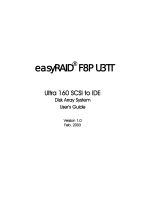
4.2 McRAID Main Window ...................................................... 48
4.3 Main Menu .................................................................... 49
4.4 Quick Function ................................................................ 49
4.5 Raid Set Functions .......................................................... 50
4.5.1 Create Raid Set ......................................................... 50
4.5.2 Delete Raid Set .......................................................... 51
4.5.3 Expand Raid Set ......................................................... 52
4.5.4 Ofine Raid Set .......................................................... 53
4.5.5 Rename Raid Set ........................................................ 53
4.5.6 Activate Incomplete Raid Set ....................................... 54
4.5.7 Create Hot Spare ....................................................... 54
4.5.8 Delete Hot Spare ........................................................ 55
4.5.9 Rescue Raid Set ......................................................... 55
4.6 Volume Set Functions ...................................................... 56
4.6.1 Create Volume Set (0/1/10/3/5/6) ............................... 57
• Volume Name ................................................................ 57
• Volume Raid Level ......................................................... 57
• Capacity ....................................................................... 57
• Greater Two TB Volume Support ....................................... 57
• Initialization Mode .......................................................... 58
• Stripe Size .................................................................... 58
• Cache Mode .................................................................. 59
• Volume Write Protection .................................................. 59
• Full Volume Encryption.................................................... 59
• Tagged Command Queuing .............................................. 60
• SCSI Channel/SCSI ID/SCSI Lun ...................................... 60
4.6.2 Create Raid30/50/60 (Volume Set 30/50/60) ................. 61
4.6.3 Delete Volume Set ...................................................... 61
4.6.4 Modify Volume Set ...................................................... 62
4.6.4.1 Volume Growth ..................................................... 63
4.6.4.2 Volume Set Migration ............................................. 63
4.6.4.3 Volume Write Protection ......................................... 64
4.6.5 Check Volume Set ...................................................... 64
4.6.6 Schedule Volume Check .............................................. 65
4.6.8 Download Volume Key File ........................................... 66
4.7 Physical Drive ................................................................ 67
4.7.1 Create Pass-Through Disk ............................................ 67
4.7.2 Modify Pass-Through Disk ............................................ 67
4.7.3 Delete Pass-Through Disk ............................................ 68
4.7.4 Clone Disk ................................................................. 68
4.7.4.1 Clone And Replace ................................................. 69
4.7.4.2 Clone Only ........................................................... 69






















